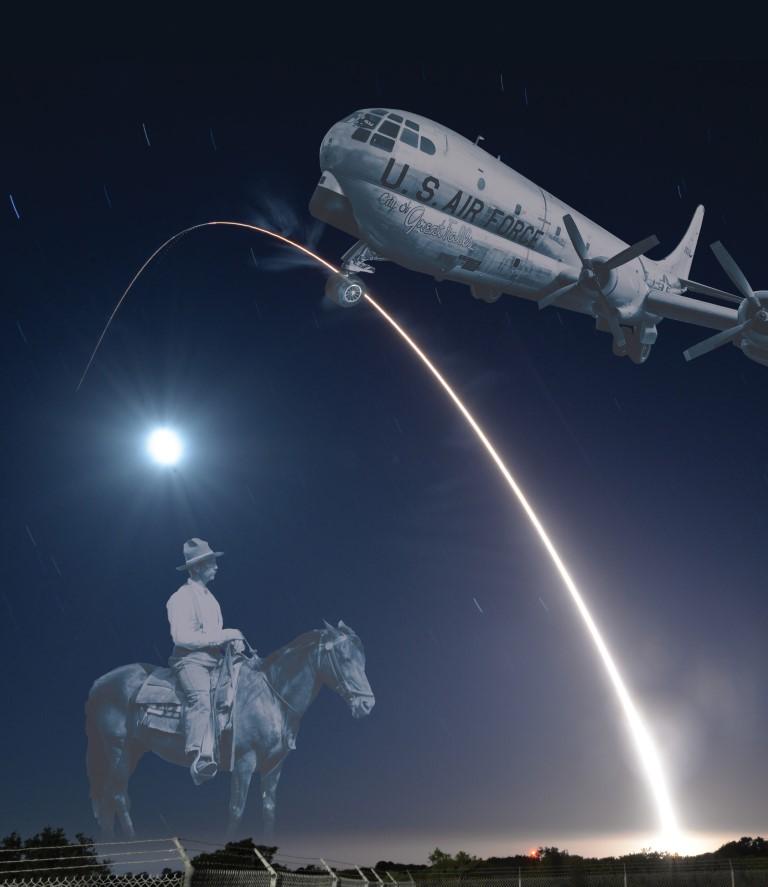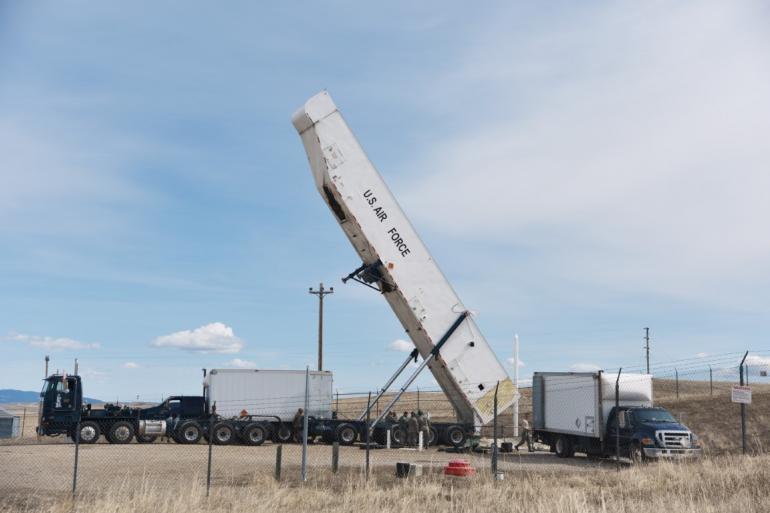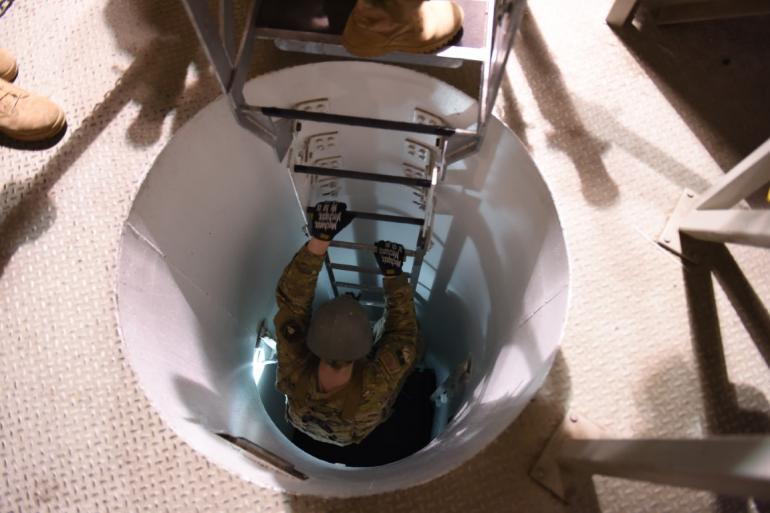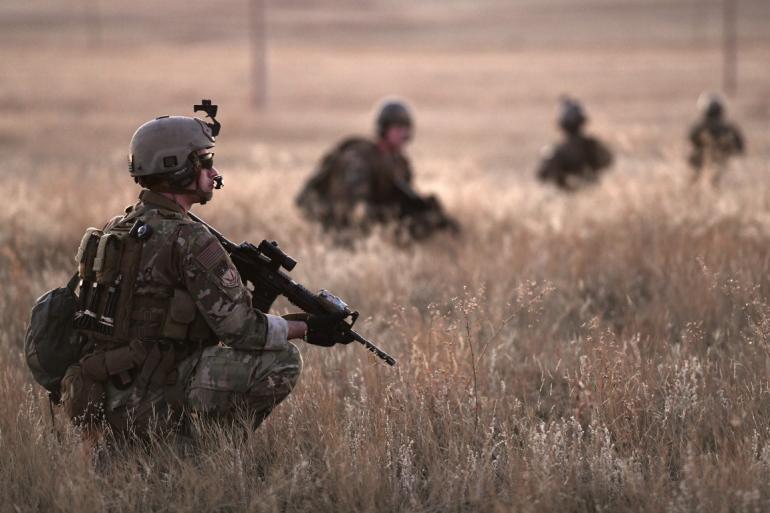From Cowboys to the Cold War:
A History of Malmstrom AFB

Thankfully, the Cold War never heated up. Aside from Truman, no President ever pressed the fabled big red button. But if one had, Montanans would have witnessed the terrible beauty of the ground opening up and issuing hundreds of Minutemen missiles. People would have pointed at the sky, tracing rocket exhaust, watching as the warheads set out for their journey across the north pole. Eventually the rockets would pound into Moscow, Leningrad, Beijing, Warsaw, and East Berlin. Yet more missiles would have fallen on cities the average Montanan has never heard of: Barabinsk, Krasnoyarsk, Chita, and hundreds of others. Some targets included bases, industrial and manufacturing centers - places of strategic importance. Others would have targeted population centers; the aim was obliteration, pure and simple.
Meanwhile, in the United States, we can imagine where they would have targeted in turn: New York, Washington D.C., Los Angeles.
But while the Cold War never escalated beyond proxy wars and nuclear proliferation, it did change Montana, and the landscape of the West, forever. As author Ian Frazier writes, the nuclear missile silo has become "one of the quintessential Great Plains objects," along with the American bison, the prairie dog, and the outhouse. Missile sites in Montana, North Dakota, Wyoming, Nebraska and Texas were selected, in part, so that a Russian (or Chinese, or North Korean—pick your poison) strike against our missile sites would result in a minimum of civilian casualties; in the calculus of strategic thinking, the United States could, in the event of a nuclear exchange, afford to lose a few cowboys, farmers, ranchers, and railroaders.
It's oddly sobering to think that, even as the Western and Eastern seaboards would have been pulver - ized, a dozen or so Soviet R-9 Desnas might have flown for Great Falls, Montana as well.
Malmstrom Air Force Base, constructed during WWII, was particularly important to Strategic Air Command when they found that the first model of ICBM, the Minuteman IA, had a defective swivel nozzle. Crucial to the missile's guidance system, the flaw meant that the effective range of the weapon was only 4300 miles instead of the projected 5000. This meant that proposed missile bases in Georgia, Texas or Oklahoma would no longer be able to reach targets in the Far East. Russia would be in range if launched from Montana, however. Soon there were 150 warheads at Malmstrom, the very first ICBM base in the Air Force, thus earning it the moniker "Wing One."Yet Malmstrom AFB was not always intended as a nuclear deterrent to Soviet Russia. In the beginning, in fact, the base actually supported Russia as part of the wartime lend-lease agreement signed into law by Franklin Delano Roosevelt. At the time, some $50 billion of weapons, planes, and oth - er materials of war were siphoned to our allies, particularly Mother Russia. Malmstrom, then called Great Falls Army Air Base, established a supply line between Montana and Ladd Field in Fairbanks, Alaska that would channel more than 1.5 million pounds of supplies to the Soviets.

Following the war, the base was renamed for Colonel Ein - ar Axel Malmstrom, a P-47 Thunderbolt Pilot and one-time commanding officer of the 356th Fighter Group. Captured by Nazi forces after being shot down over France in 1944, he spent the last year of the war as a POW in Stalag Luft 1. After it was liberated in May 1945, he was awarded the Bronze Star. He would go on to serve at the 312th Base Unit in Barksdale, Louisiana and the 19th Tactical Air Command in Biggs, Texas, before being reassigned to what was then called Great Falls AFB in February of 1954. He was designated Deputy Wing Commander of the 407th Strategic Fighter Wing but, sadly, he would die in a T-33 fighter jet crash only six months later in August of the same year. In 1955, Great Falls AFB was renamed in his honor.
During the mid to late 1950s, with the Korean War concluded and the Cold War coming to dominate US foreign policy, the base began shifting priorities to supporting long-range B-36 bombers via refueling and escort missions. Not coincidentally, the first ICBMs arrived in 1962, just months before the Cuban Missile Crisis reinforced their strategic necessity. At the height of the Cold War, Malmstrom was home to bomber wings that delivered nuclear bombs, fighter jets that were able to launch nuclear rockets, and hundreds of Minuteman, Titan, Titan II, and Atlas ICBMs.
In short, according to Public Affairs Officer 2d Lt Daniel J Lindstrom and base historian Troy Halsell, Ph.D., who we consulted for this story, "the mission has changed for Malm - strom. It used to be a refueling wing, but since 1996 it only has an ICBM mission. Whereas the Cold War-era perhaps focused more on nuclear proliferation and the imminent threat of nuclear war, the current mission focuses mainly on deterring adversaries from conducting nuclear and non-nu - clear strategic attack against the United States and our allies and partners, and on underwriting American military forces globally."
Today Malmstrom AFB employs about 2000 people whose jobs are specifically related to maintaining the ICBMs still on-site. According to Halsell, "that number includes Security Forces—who ensure the safety of the assets, Maintainers—who ensure the ability of the ICBMs to function properly, engineers—who take care of the structures that house and transport ICBMs, and missile combat crews—who are on call 24/7/365, ready to respond at a moment's notice."

The LGM-30 Minuteman-III missile, introduced in 1970, is the only land-based ICBM currently still in use by the American Armed Forces. Malmstrom is home to roughly a third of the 400 existing Minuteman III missiles. The aging design is more than fifty years old, prompting some concerns regarding the computer systems and infrastructure surrounding them. But in 2020, aerospace and defense company Northrop Grumman was awarded a $13.3 billion contract to design, build and deliver their successor, the Ground Based Strategic Deterrent, or GBSD. The move is not without controversy, as the cost of replacing the Minuteman III missiles is estimated to be about $1 trillion.
Even so, as Lindstrom and Halsell report, GBSD "will make the ground-based leg of the nuclear triad more modular, with open system architecture, and it will be adaptable and more maintenance-friendly. This is especially important given the challenges posed by the pace of technological change and competition from our near-peer adversaries in Russia and China. The refurbishment of our Missile Alert Facilities will take place over the next five years and GBSD construction is currently estimated to begin in 2026."
One thing is for sure: the updated weapons system will ensure that Malmstrom AFB will be strategically vital for decades to come—Northrop Grumman intends to produce a weapons system with the "adaptability to affordably address changing technology and emerging threats through 2075."
Though the threats have changed over the nearly 80 years of Malmstrom's existence, it has continued to help protect our country and deter our enemies, and it seems the base, and the brave and skilled men and women stationed there, will continue to do so for many years to come.
And residents of the city of Great Falls will surely continue to pray that they never look up to see rockets departing the base.
Or arriving, for that matter.













Leave a Comment Here